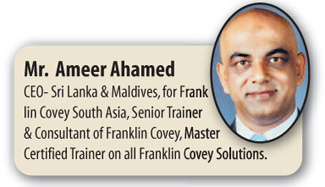As we discussed about the Time Matrix Quadrants in the few weeks ,let me share as to how we can move in Quadrant Two, which we call as Productivity Quadrant, or Effectiveness Quadrant or even Leadership Quadrant.
 In order to get more benefits from this quadrant we looked at last week from a different perspective like "how we can say No? having a deeper Yes inside us". Today let’s look at how we can move further into Quadrant two. In order to get more benefits from this quadrant we looked at last week from a different perspective like "how we can say No? having a deeper Yes inside us". Today let’s look at how we can move further into Quadrant two.
If Quadrant II activities are clearly the heart of effective personal management - the "first things" we need to put first - then how do we organize and execute around those things?
The first generation of time management does not even recognize the concept of priority. It gives us notes and "to do" lists that we can cross off, and we feel a temporary sense of accomplishment every time we check something off, but no priority is attached to items on the list. In addition, there is no correlation between what's on the list and our ultimate values and purposes in life. We simply respond to whatever penetrates our awareness and apparently needs to be done.
Many people manage from this first-generation paradigm. It's the course of least resistance. There's no pain or strain; it's fun to "go with the flow".
Externally imposed disciplines and schedules give people the feeling that they aren't responsible for results.
But first-generation managers, by definition, are not effective people. They produce very little, and their life-style does nothing to build their production capability. Buffeted by outside forces, they are often seen as undependable and irresponsible, and they have very little sense of control and self-esteem.
Second-generation managers assume a little more control. They plan and schedule in advance and generally are seen as more responsible because they "show up" when they're supposed to. But again, the activities they schedule have no priority or recognized correlation to deeper values and goals. They have few significant achievements and tend to be schedule oriented.
Third-generation managers take a significant step forward. They clarify their values and set goals. They plan each day and prioritize their activities.
As I have said, this is where most of the time management field is today. But this third generation has some critical limitations. First, it limits vision - daily planning often misses important things that can only be seen from a larger perspective. The very language "daily planning" focuses on the urgent - the "now". While third generation prioritization provides order to activity, it doesn't question the essential importance of the activity in the context of principles, personal mission, roles, and goals.
The third-generation value-driven daily planning approach basically prioritizes the Quadrant I and III problems and crises of the day.
In addition, the third generation makes no provision for managing roles in a balanced way. It lacks realism, creating the tendency to over-schedule the day, resulting in frustration and the desire to occasionally throw away the plan and escape to Quadrant IV. And its efficiency, time management focus tends to strain relationships rather than build them.
While each of the three generations have recognized the value of some kind of management tool, none has produced a tool that empowers a person to live a principle-centered, Quadrant II life-style. The first-generation notepads and "to do" lists give us no more than a place to capture those things that penetrate our awareness so we won't forget them. The second-generation appointment books and calendars merely provide a place to record our future commitments so that we can be where we have agreed to be at the appropriate time.
Even the third generation, with its vast array of planners and materials, focuses primarily on helping people prioritize and plan their Quadrants I and III activities. Though many trainers and consultants recognize the value of Quadrant II activities, the actual planning tools of the third generation do not facilitate organizing and executing around them.
As each generation builds on those that have preceded it, the strengths and some of the tools of each of the first three generations provide elementary material for the fourth. But there is an added need for a new dimension, for the paradigm and the implementation that will empower us to move into Quadrant II, to become principle-centered and to manage ourselves to do what is truly most important.
|

 In order to get more benefits from this quadrant we looked at last week from a different perspective like "how we can say No? having a deeper Yes inside us". Today let’s look at how we can move further into Quadrant two.
In order to get more benefits from this quadrant we looked at last week from a different perspective like "how we can say No? having a deeper Yes inside us". Today let’s look at how we can move further into Quadrant two.